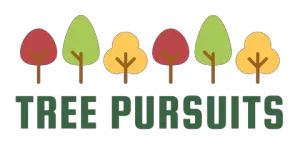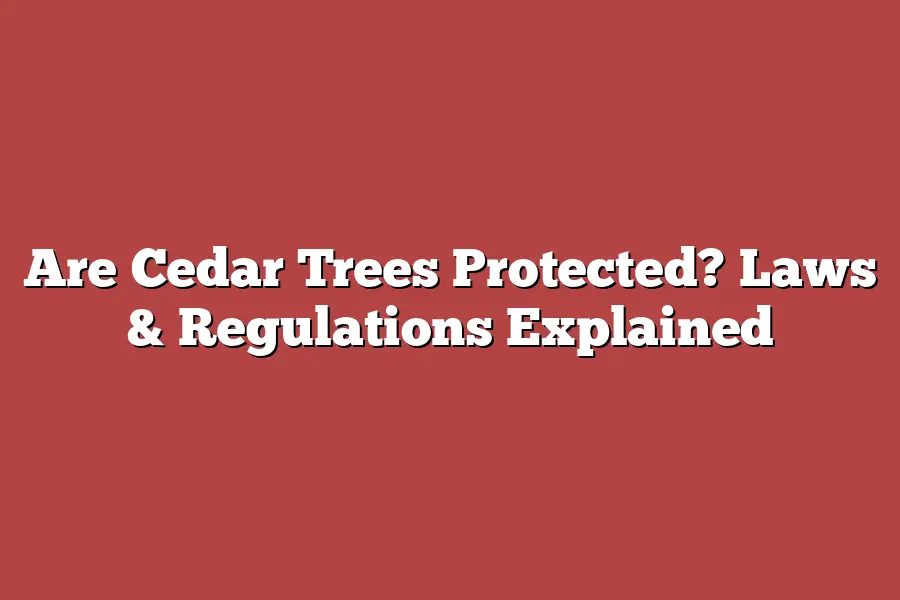Cedar trees, particularly those found in North America, are protected under various laws and regulations. The U.S. Endangered Species Act (ESA) lists several species of cedar as threatened or endangered, while international agreements such as CITES regulate their trade. Additionally, many states and countries have implemented conservation efforts to protect cedar habitats and prevent over-harvesting. Overall, while not all cedar trees are protected, many species are safeguarded by laws and regulations.
As a passionate advocate for preserving our planet’s precious natural resources, I’ve had the privilege of delving into the fascinating world of cedar trees.
With their majestic presence and fragrant aroma, these towering giants have captivated human imagination for centuries.
But beyond their aesthetic appeal, cedar trees hold a special place in the ecosystem, providing crucial habitat for countless species and playing a vital role in regulating our environment.
As I’ve explored the complex legal framework surrounding cedar tree protection, I’m struck by the intricate web of national and international laws designed to safeguard these remarkable organisms.
From the Endangered Species Act (ESA) in the United States to the Convention on International Trade in Endangered Species of Wild Fauna and Flora (CITES), it’s clear that governments around the world recognize the critical importance of preserving cedar trees for future generations.
In this blog post, I’ll be taking a closer look at the legal framework governing cedar tree protection, from national laws to international agreements.
I’ll also explore successful conservation efforts and innovative initiatives aimed at protecting these incredible ecosystems.
So join me on this journey as we uncover the fascinating world of cedar tree protection and discover what it takes to safeguard these natural wonders for generations to come.
Table of Contents
Legal Framework: National and International Laws
When it comes to protecting cedar trees, a robust legal framework is crucial.
In this section, we’ll dive into the national and international laws that safeguard these magnificent species.
Protecting Cedar Trees at Home: The Endangered Species Act (ESA) in the United States
As I’m sure you know, the United States has an impressive track record when it comes to conservation efforts.
One of the most effective tools in our environmental toolkit is the Endangered Species Act (ESA).
This landmark legislation, signed into law by President Nixon in 1973, provides a critical safety net for threatened and endangered species – including cedar trees.
Under the ESA, the US Fish and Wildlife Service (USFWS) works tirelessly to identify, list, and protect species that are at risk of extinction.
When it comes to cedar trees, the ESA has been instrumental in conserving iconic species like the eastern red cedar (Juniperus virginiana).
Take the case of the Ashe juniper (Juniperus ashei), a critically endangered subspecies endemic to Texas.
Thanks to the ESA, conservation efforts have been underway since 1995 to protect this majestic tree.
By listing the Ashe juniper under the ESA, we’ve seen a significant reduction in habitat destruction and fragmentation – giving this species a fighting chance at recovery.
Going Global: The Convention on International Trade in Endangered Species of Wild Fauna and Flora (CITES)
While national laws like the ESA are essential for protecting cedar trees within specific countries, international agreements like CITES are vital for addressing the global trade and conservation issues surrounding these species.
Established in 1973 – the same year as the ESA – CITES is an international treaty that regulates the trade of endangered wildlife, including plants.
This agreement brings together over 180 countries to ensure that the global trade in endangered species doesn’t drive them closer to extinction.
CITES has been instrumental in regulating the trade of cedar trees and their products.
For instance, many cedar wood products are regulated under CITES Appendix III, which restricts international trade in these materials unless they’re sourced from certified sustainable forests or have undergone rigorous inspections to ensure they don’t come from endangered populations.
Conservation Success Stories: The Power of Laws
So, what does all this mean for the conservation status of cedar trees?
Let me tell you – it’s been a game-changer!
By having robust laws in place at both the national and international levels, we’ve seen some incredible conservation success stories.
Take the example of the western red cedar (Thuja plicata).
Thanks to a combination of CITES regulations and ESA listings, this iconic species has made significant gains.
According to the USFWS, the western red cedar is no longer considered endangered – a testament to the power of effective laws and conservation efforts!
In conclusion, the legal framework surrounding cedar trees is robust and multifaceted.
By combining national and international agreements, we can ensure that these incredible species continue to thrive for generations to come.
Regulations for Harvesting and Trade: Permits, Certifications, and Reporting
So, you’re wondering if cedar trees are protected?
Well, I’m here to give you the lowdown on the regulations surrounding these magnificent trees.
From permits to certifications, it’s a wild ride!
Buckle up, folks!
The Permit Process: Harvesting Cedar Trees with US Forest Service
When it comes to harvesting cedar trees in the United States, you’ll need a permit from the US Forest Service (USFS).
Think of it like getting permission to borrow your neighbor’s lawnmower – you gotta ask nicely and follow the rules!
This permit is required for any timber harvesting activity on public lands, including national forests.
The USFS issues two types of permits: one for commercial harvests and another for non-commercial activities.
The former requires a detailed plan, while the latter is more straightforward.
Don’t worry; I won’t bore you with too many details – just know that these permits are essential for ensuring responsible cedar tree harvesting.
Certifying Sustainable Forestry: PEFC and FSC
Now that we’ve covered permits, let’s talk about certifications!
Two prominent schemes are the Programme for the Endorsement of Forest Certification (PEFC) and the Forest Stewardship Council (FSC).
Think of these as badges of honor for sustainable forestry practices!
The PEFC is an international organization that certifies forest management based on rigorous standards.
In Canada, where cedar trees are abundant, the PEFC certification covers around 30% of the country’s forests.
Meanwhile, the FSC is a more well-known scheme, with over 250 million hectares of certified forests worldwide.
This organization sets strict guidelines for responsible forestry practices, including protection of biodiversity and indigenous communities.
Reporting Requirements: Annual Surveys in Canada
In Canada, where cedar trees are a significant industry, reporting requirements come into play.
The Canadian government requires annual surveys to monitor cedar tree harvests.
Think of it like keeping track of your garden’s progress – you want to know what’s working and what’s not!
These surveys help authorities keep tabs on forest health, sustainability, and environmental impact.
By reporting these numbers, Canada ensures transparency and accountability in the forestry industry.
There you have it!
A whirlwind tour of regulations for harvesting and trading cedar trees.
From permits to certifications and reporting requirements, there’s no shortage of rules to follow.
But hey, that’s what keeps our beloved cedar trees safe and sustainable!
Conservation Efforts: Reforestation, Rehabilitation, and Community Engagement
When it comes to protecting our beloved cedar trees, conservation efforts are crucial.
But what exactly do these efforts entail?
In this section, we’ll delve into the world of reforestation, rehabilitation, and community engagement – three vital components that work together to ensure the long-term survival of our majestic cedars.
Reforestation: Restoring the Forests We’ve Lost
Wildfires and logging have left their mark on cedar forests around the world.
But through reforestation efforts, we can restore these areas to their former glory.
It’s a multi-faceted process that involves planting new trees, reintroducing native species, and creating a healthy ecosystem.
Take the example of the Cedar River State Park in Iowa, USA.
After a devastating flood in 2008, conservationists worked tirelessly to replant cedar and other tree species.
Today, the park is thriving once more – a testament to the power of reforestation.
Rehabilitation: Giving Degraded Habitats a Second Chance
Not all habitats are created equal.
Some areas have been degraded or damaged due to human activity or natural disasters.
That’s where rehabilitation programs come in.
These initiatives focus on reintroducing native cedar species to these degraded habitats, often using innovative techniques like nursery-grown trees or seedlings.
For instance, the United States Forest Service has implemented a successful rehabilitation program in the Rocky Mountains, where they’re working to restore cedar forests damaged by logging and fires.
Community Engagement: Educating and Empowering Local Communities
Conservation efforts aren’t just about reforestation and rehabilitation – they also involve community engagement.
By educating local communities and indigenous peoples about the importance of cedar conservation, we can empower them to take ownership of these efforts.
This might include workshops on sustainable forest management, tree-planting events, or even traditional ecological knowledge-sharing programs.
Take the example of the Tsilhqot’in Nation in British Columbia, Canada.
Through a community-led initiative, they’re working to restore cedar forests and promote ecological stewardship among their people.
In conclusion, conservation efforts are a vital part of protecting our beloved cedar trees.
By combining reforestation, rehabilitation, and community engagement, we can create a harmonious balance between human activity and the natural world.
So the next time you find yourself surrounded by the majestic scent of cedars, remember the incredible work being done to preserve these treasured species for generations to come.
Final Thoughts
As I wrap up this exploration of laws and regulations protecting cedar trees, I’m left with a sense of hope.
It’s clear that there are dedicated efforts underway to safeguard these majestic creatures and their habitats.
From national laws like the ESA to international agreements like CITES, it’s reassuring to see governments and organizations working together to ensure the long-term survival of cedar trees.
Of course, there’s still much work to be done.
As consumers, we have a crucial role to play in supporting sustainable forestry practices and promoting conservation efforts.
By making informed choices about the products we use and the companies we support, we can help drive positive change for these incredible trees.
So let’s do our part – together, we can make a difference for cedar trees and the ecosystems they call home.


